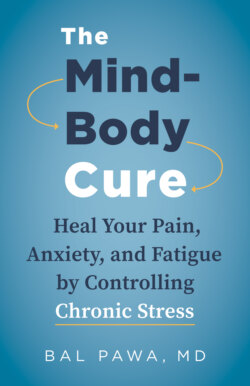Читать книгу The Mind-Body Cure - Bal Pawa - Страница 35
На сайте Литреса книга снята с продажи.
➤ Homeostasis: Balancing the Gas with the Brakes
ОглавлениеI often like to compare the autonomic nervous system with a car engine. The sympathetic nervous system functions to stimulate—or rev up—the body, so I refer to it in this book as “the gas.” Also known as the fight-or-flight reaction, it is one of our most primitive systems, designed to prepare the body for stressful or emergency situations. The SNS allowed us to run away from predators, and these lightning-speed stress reflexes still keep us out of harm’s way—such as swerving to avoid an oncoming car—on a daily basis. Our body is designed to handle this shortterm stress reaction and then return to a normal, resting state called homeostasis.
When the body senses danger, the SNS is activated and the brain sends a signal to the adrenal glands to release the stress hormones adrenaline and cortisol. Activating the SNS increases heart rate, makes the heart contract with more force, and widens the airways to make breathing easier. It releases stored energy to increase muscle strength and blood sugar, and it causes the pupils to dilate. At the same time, it slows down body processes such as digestion and urination that are less important in dealing with an imminent threat.
The human body is not designed to remain revved up for long periods of time. In fact, all living things tend toward homeostasis, or equilibrium, and our bodies are no different. When our systems remain within certain pre-set limits—a body temperature of 98.6°F or a heart rate of 60 to 100 beats per minute, for example—they are better able to function optimally, which means better health. Our ancestors may have triggered their SNS regularly, but these episodes of cortisol and adrenaline surging through their bodies were mostly short-lived. Once our ancestors got away from danger, their brains deemed the external environment safe again and their heart rate slowed, their breathing eased, and their stress levels dropped. In other words, our ancestors found time to recover and soothe themselves by eating and sleeping. Most animals still do this: ducks ruffle their feathers and cats lick themselves to return to balance.
In humans, the parasympathetic nervous system (PNS) functions to inhibit—or slow down—the body and bring about this equilibrium, which is why I refer to it in this book as “the brakes.” Also known as the rest-and-digest response, it releases hormones and chemicals that relax the body and allow it to recover its normal functioning. When the body is no longer under threat, the PNS is activated and the brain signals the body to release dehydroepiandrosterone (DHEA), a hormone associated with longevity and health; our happy hormone, serotonin; and our natural painkillers, the endorphins. Activating the PNS enhances blood flow to the gut, increases contractions of the gut and release of gastric juices, and turns on secretions that aid the digestion process. At the same time, it slows our heart rate to a resting state and reduces our blood pressure by allowing our blood vessels to return to their usual diameter. In essence, almost every one of our body systems returns to a resting state. It’s like putting up our feet and sipping lemonade on our porch swing.
This intricate system of gas (SNS) and brakes (PNS) operates as a series of checks and balances, ensuring that neither system dominates and that our body returns to homeostasis. In some people, this system becomes overactive (the gas is on all the time). In many of us, the ANS becomes dysfunctional and goes into alarm phase even when there’s only minimal stress. Too much gas for too long will create discomfort and disease. So to address the root cause of stress-induced discomfort and disease, we must look at how our mind interacts with the ANS at every instant—how it hits the gas or pumps the brakes, depending on our internal thoughts—and learn to regulate it with conscious effort.
